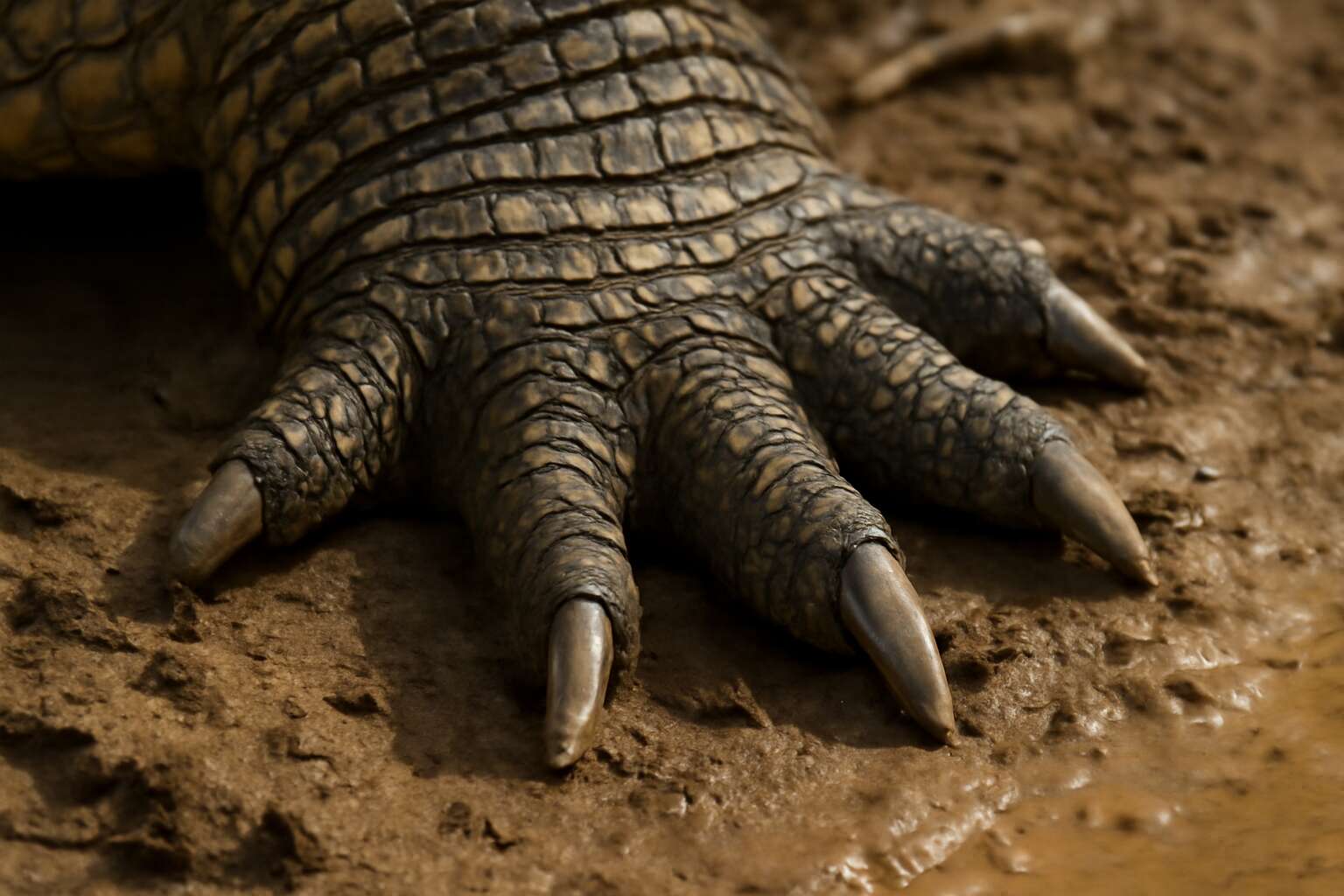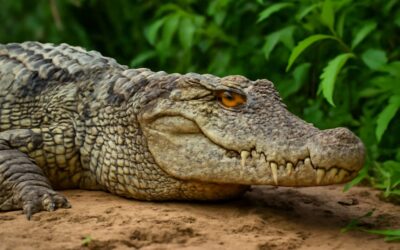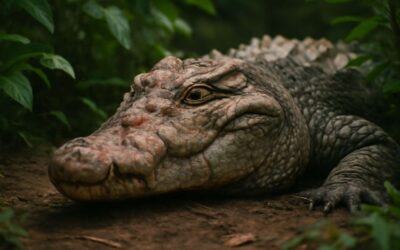Anatomy of Crocodile Feet
Overview of Crocodile Foot Structure
When you observe a crocodile’s feet, you’re witnessing a marvel of evolutionary adaptation. These formidable creatures boast feet that are perfectly tailored for both stealth and power, reflecting their ancient lineage. The anatomy of crocodile feet reveals a fascinating blend of strength and flexibility, allowing them to traverse a variety of terrains with astonishing efficiency.
The structure of crocodile feet is characterised by a robust skeletal framework, with each toe equipped with sharp claws that aid in gripping slippery surfaces and digging. The webbing between their toes is not just for swimming but also provides stability on land. Interestingly, crocodile feet are semi-webbed, a feature that grants them the ability to switch seamlessly between aquatic and terrestrial environments.
Within their foot anatomy, the following elements stand out:
- Strong phalanges that support swift movements
- Flexible webbing aiding in propulsion during swimming
- Powerful claws for digging and gripping
- Muscular pads that cushion their steps on rough terrain
This intricate design exemplifies how crocodile feet are more than mere appendages; they are a testament to millions of years of evolutionary refinement, enabling these ancient predators to dominate both water and land.
Digits and Claw Arrangement
In the grand theatre of evolution, crocodile feet stand out as a masterclass in functional design. The intricate arrangement of digits and claws reflects a delicate balance between strength and agility, enabling these ancient predators to excel both on land and in water. Each digit, meticulously supported by sturdy phalanges, contributes to the overall stability and swift movement characteristic of crocodiles. Their claws, sharp and formidable, are not mere tools of intimidation but essential for gripping slippery surfaces and digging into the earth with precision.
What truly sets crocodile feet apart is their specialised claw arrangement, which promotes versatility across diverse terrains. The claws are positioned to allow optimal leverage, whether they are manoeuvring through murky waters or stalking prey on muddy banks. Interestingly, the digits themselves are often arranged in a manner that facilitates a semi-webbed foot structure, granting a seamless transition from aquatic propulsion to terrestrial ambulation. This sophisticated digit and claw configuration exemplifies millions of years of evolutionary refinement, making crocodile feet a fascinating subject of study for both naturalists and enthusiasts alike.
Webbing and Its Functions
The anatomy of crocodile feet is a masterclass in nature’s engineering, perfectly adapted for a life both on land and in water. Central to this versatility is the webbing that extends between their digits, creating a semi-aquatic marvel. This webbing acts like a flexible paddle, allowing crocodiles to glide seamlessly through murky waters with minimal effort and maximum grace.
The webbed structure isn’t just for propulsion; it also provides crucial stability when they crawl onto muddy banks or sluggishly stalk prey. The webbing’s delicate yet resilient fabric stretches and contracts with each movement, enhancing their efficiency in aquatic environments while maintaining agility on land. This dual function underscores the extraordinary evolution of crocodile feet, where form and function are intertwined in perfect harmony.
Interestingly, the webbing can vary slightly among different species of crocodiles, adapting to their specific habitats. In some, the webbing extends further, creating a broader paddle, while in others, it is more limited, favouring terrestrial agility. This subtle variation highlights the intricate relationship between anatomy and environment—a testament to millions of years of evolutionary refinement.
Comparison with Other Reptile Feet
When comparing crocodile feet to other reptiles, the differences are as striking as a well-tailored suit at a black-tie event. While many reptiles sport simple, clawed digits designed for crawling, crocodile feet exemplify evolutionary sophistication. Their webbing, unique among reptiles, transforms these formidable appendages into semi-aquatic marvels—perfectly adapted for both stalking prey on land and gliding through murky waters.
Unlike the sprawling, less specialised feet of lizards or the sprawling, paddle-like appendages of certain turtles, crocodile feet strike a delicate balance. They possess a combination of robust claws for gripping and webbing that acts as a paddle, making them true aquatic hybrids. This duality is what sets crocodile feet apart in the reptile kingdom, allowing them to navigate diverse terrains with astonishing ease.
- Webbing is more extensive in aquatic species, aiding in propulsion.
- Terrestrial species tend to have shorter webbing, prioritising land agility.
- The claw arrangement complements webbing, providing both grip and stability.
In essence, crocodile feet are an evolutionary triumph—an intricate blend of form and function that surpasses many of their reptilian kin. Their specialised anatomy exemplifies nature’s knack for fine-tuning adaptations, making them a fascinating subject for anyone captivated by the marvels of evolution and the subtle art of survival. Truly, crocodile feet are a testament to millions of years of environmental dialogue—an elegant compromise between land and water mastery.
Functionality of Crocodile Feet
Locomotion and Movement
The remarkable functionality of crocodile feet plays a pivotal role in their mastery of both land and water environments. Their unique foot structure allows for efficient locomotion, facilitating swift sprints on muddy banks and graceful glides through aquatic habitats. Unlike many reptiles, crocodiles possess a combination of strong, muscular limbs and webbed feet that enable them to switch seamlessly between walking, running, and swimming. This versatility is a testament to millions of years of evolutionary refinement.
When it comes to movement, crocodile feet exhibit an impressive adaptation — the ability to generate powerful push-offs from a standing start, thanks to their sturdy, clawed toes. Additionally, the webbing between their toes expands and contracts, helping them to conserve energy during long swims or when stalking prey. Their feet are not just passive appendages; they are finely tuned instruments designed for stability, speed, and agility in their complex habitats.
In fact, crocodile feet are so specialised that they often resemble miniature paddles, especially in aquatic scenarios. This paddling motion is essential for their survival, enabling them to ambush prey with startling speed or traverse vast stretches of water with minimal effort. From a biological perspective, crocodile feet exemplify an extraordinary fusion of form and function—each movement a calculated dance honed over eons.
Hunting and Feeding Adaptations
The extraordinary functionality of crocodile feet is a marvel of evolutionary engineering, especially when it comes to hunting and feeding strategies. These resilient limbs are finely tuned for stealth and power, enabling crocodiles to ambush prey with astonishing precision. Their feet act like miniature paddles, allowing for swift, silent movements in the water—an essential trait for successful predation in aquatic habitats.
Adapted for both stalking and rapid pursuit, crocodile feet feature a combination of muscular strength and webbing that enhances their ability to generate explosive pushes from a standstill. This burst of speed often catches prey off guard, making crocodiles some of the most formidable ambush predators. Furthermore, the webbing between their toes expands during swimming, providing increased surface area for propulsion and conserving energy over long distances.
In addition to aiding movement, crocodile feet play a vital role in feeding adaptations. Their sturdy, clawed toes help grip and manipulate prey, while the webbing ensures stability during sudden lunges or swift retreats into water. The intricate design of crocodile feet embodies the perfect balance between manoeuvrability and strength, a testament to millions of years of natural selection honing their survival skills in complex environments.
Thermoregulation and Habitat Interaction
Amidst the murmur of ancient waters, crocodile feet serve as more than mere appendages; they are masterful tools for thermoregulation and habitat interaction. These formidable limbs assist in controlling body heat, an essential survival trait in the fluctuating climates of their native environments. When basking on riverbanks, crocodiles often position their feet to absorb or shed heat, their webbed toes acting as natural radiators or coolers, depending on the need. This delicate balance allows them to maintain optimal body temperature, crucial for their predatory prowess.
Furthermore, crocodile feet are intricately adapted for seamless interaction with their habitat. The webbing between their toes not only enhances aquatic locomotion but also grants stability on muddy banks and uneven terrain. In fact, their feet serve as versatile tools, helping them anchor securely in submerged vegetation or climb onto sunlit embankments. The multifunctional design of crocodile feet exemplifies a harmonious fusion of strength, stealth, and environmental harmony, making these creatures true masters of their domain.
Unique Features of Crocodile Feet
Webbing for Swimming Efficiency
In the silent dance of survival, crocodile feet reveal a marvel of evolutionary artistry. The webbing between their toes acts like a finely woven net, transforming each foot into a paddle designed for aquatic mastery. This intricate webbing allows crocodiles to glide through water with astonishing grace, reducing drag and increasing propulsion. Such features elevate their swimming efficiency to near perfection, making them formidable predators in their watery realm.
What sets crocodile feet apart is the remarkable flexibility of their webbing, which can stretch and contract as needed. This dynamic adaptation ensures that when submerged, their feet behave like efficient oars, while on land, they retract to support stability and grip. The webbing’s adaptability is a testament to nature’s ingenuity, allowing crocodiles to transition seamlessly between stalking prey in the water and basking on riverbanks.
Indeed, the unique webbing of crocodile feet exemplifies a perfect harmony of form and function. It is a feature that not only boosts their swimming prowess but also underscores their role as apex predators in diverse habitats. The webbing’s design is a silent symphony of evolution, whispering tales of survival and dominance beneath the surface of their aquatic domains.
Strong Claws for Gripping
Among the many marvels of crocodile feet, one feature stands out with impressive prowess: their robust claws. These strong claws serve as nature’s gripping tools, allowing crocodiles to hold onto slippery prey and secure themselves firmly on varied surfaces. What makes these claws extraordinary is their ability to puncture and grip with precision, even in the most challenging environments.
Unlike other reptiles, crocodile feet possess claws that are not only sharp but also incredibly durable. This durability ensures they can withstand the rigours of their predatory lifestyle, whether clutching a struggling fish or scrambling over muddy banks. The claws are complemented by the muscular strength of their limbs, enabling swift and powerful movements that keep them at the top of the aquatic food chain.
In addition, the arrangement of their claws showcases a remarkable evolutionary adaptation. Some of the claws are curved and pointed, ideal for gripping, while others are broader, providing stability on land. This combination creates a versatile toolset that enhances their survival in diverse habitats. The claws’ formidable grip is often the decisive factor in successful hunting and territory defence, cementing crocodile feet as a symbol of predatory mastery in the wild.
Foot Flexibility and Strength
When it comes to the marvels of crocodile feet, their unique combination of flexibility and brute strength is nothing short of astonishing. Unlike many reptiles that are stiff as a board, crocodile feet exhibit a surprising degree of adaptability, allowing these ancient predators to navigate both aquatic and terrestrial terrains with ease. This remarkable foot flexibility is thanks to an intricate network of tendons and muscles that give their feet a surprising range of motion—imagine the agility of a gymnast, but with the jawpower of a heavyweight boxer.
What truly sets crocodile feet apart is their ability to generate immense force while maintaining a delicate touch—perfect for gripping slippery prey or anchoring themselves on muddy riverbanks. Their muscular limbs act as a hydraulic system, giving each step the precision and power needed to ambush unsuspecting prey or propel themselves through water with incredible speed. This combination of flexibility and strength makes crocodile feet the ultimate tool for survival in their ever-changing habitats.
In fact, a typical crocodile foot features a blend of elements—such as tapered digits for gripping and broader pads for stability—that work together seamlessly. Think of it as a finely tuned orchestra of biological engineering. The impressive flexibility and strength of crocodile feet showcase an evolutionary masterpiece, ensuring these formidable creatures remain at the top of the food chain, no matter what environment they find themselves in.
Evolution and Adaptation of Crocodile Feet
Evolutionary Development
In the grand theatre of evolution, crocodile feet have undergone a remarkable metamorphosis, sculpted by the relentless hand of nature’s ingenuity. These ancient limbs, once simple paddles, have evolved into complex tools of survival, demonstrating nature’s mastery of adaptation. The evolutionary journey of crocodile feet reveals a fascinating story of precision—each digit and webbing meticulously designed to meet the demands of both land and water. As their ancestors transitioned from primitive amphibians to formidable predators, their feet adapted, balancing the need for swift movement with the subtle art of stealth in murky waters.
The development of webbing in crocodile feet exemplifies a masterstroke of evolutionary engineering—enhancing swimming efficiency while still affording traction on muddy banks. Over millennia, their feet have become a testament to the delicate balance of strength and flexibility. This evolutionary harmony allows crocodiles to glide silently beneath the water’s surface, their feet acting as both paddles and stabilisers. Such adaptation underscores a profound truth: crocodile feet are not merely limbs but symbols of survival etched into the fabric of ancient history.
Environmental Adaptations
In the grand saga of evolution, crocodile feet exemplify nature’s flair for engineering brilliance. These ancient limbs have transformed from mere paddles into sophisticated survival tools, perfectly tuned to their dual existence on land and in water. Remarkably, this adaptation isn’t accidental—it’s a carefully orchestrated ballet of genetic tweaks and environmental pressures. For example, the webbing in crocodile feet isn’t just for show; it acts like a built-in aquatic propulsion system, propelling these formidable predators through murky waters with effortless grace.
The environmental demands of swampy banks and riverbeds have shaped crocodile feet into versatile marvels. Their strong claws grip slippery surfaces, while the flexible yet sturdy structure allows for silent stalking. Such features exemplify a natural balancing act—strength where needed, subtlety where it counts. Evolution didn’t just give crocodile feet a facelift; it crafted a masterpiece of biomechanical efficiency, proving once again that in the animal kingdom, adaptability is king. This intricate design underscores the profound relationship between crocodile feet and their habitat, showcasing an ongoing chapter in the epic story of evolution and environmental adaptation.
Comparison with Fossil Crocodiles
When we peer into the ancient archives of fossilised crocodiles, the evolutionary story of their feet unfolds like a fascinating saga of adaptation and resilience. Fossil evidence reveals that early crocodile ancestors possessed feet remarkably similar to their modern descendants, hinting at a long-standing design finely tuned to their dual habitats. Over millions of years, these creatures have honed their crocodile feet into versatile instruments of survival, a testament to nature’s relentless drive for optimisation.
The transition from primitive limb structures to the sophisticated webbed feet we observe today exemplifies a masterclass in evolutionary refinement. Notably, comparison with fossil crocodiles shows that their feet have retained key features—such as robust claws and flexible joints—while evolving webbing to enhance aquatic agility. This evolutionary continuity underscores how environmental pressures, like riverbank stability and water navigation, have sculpted crocodile feet into a marvel of biomechanical engineering.
In fact, the adaptations observed in crocodile feet reflect an intricate balance: they are designed for silent stalking on muddy banks yet powerful enough to propel them through water with precision. This evolutionary journey, spanning millions of years, illustrates a remarkable case of form following function, cementing crocodile feet as a quintessential example of nature’s ingenuity. Truly, each step in their evolutionary saga whispers the secrets of resilience and adaptability that continue to define these ancient predators.
Importance of Crocodile Feet in Ecosystems
Role in Predator and Prey Dynamics
Within the intricate tapestry of ecosystem dynamics, crocodile feet play an often overlooked yet vital role. These formidable appendages are not just tools for movement; they are essential components that influence predator and prey interactions in aquatic and terrestrial habitats. The strength and dexterity of crocodile feet enable these ancient predators to stalk cautiously, ambush with precision, and navigate a variety of terrains with surprising agility.
Crocodile feet contribute significantly to their hunting prowess. Their powerful claws grip slippery surfaces and hold onto prey firmly, ensuring a swift, effective capture. This gripping ability helps maintain the delicate balance in predator-prey relationships, preventing overpopulation of certain species while supporting biodiversity. Moreover, the webbing between the toes enhances swimming efficiency, allowing crocodiles to approach prey stealthily from the water’s edge. Such adaptations make crocodile feet indispensable for their survival and ecological dominance in freshwater and coastal ecosystems.
Impact on Habitat Health
Crocodile feet are more than just remarkable appendages; they are vital for maintaining healthy habitats and ensuring ecological balance. These formidable yet adaptable structures influence not only the crocodile’s survival but also the health of entire ecosystems. When crocodiles utilise their feet to traverse both water and land, they help shape the environment in subtle but significant ways.
By carefully navigating their surroundings with powerful claws and webbed toes, crocodiles facilitate the redistribution of nutrients within their habitat. Their movement prevents habitat stagnation, promoting water flow and sediment mixing—crucial processes that uphold aquatic health. Moreover, crocodile feet assist in controlling prey populations, which in turn prevents overgrazing of aquatic plants and maintains a diverse habitat. This natural regulation supports a balanced ecosystem, ensuring that both predator and prey thrive in harmony.
- Healthy aquatic vegetation
- Balanced prey populations
- Improved water quality
- Enhanced biodiversity
It’s fascinating how the seemingly simple design of crocodile feet has such far-reaching impacts on habitat health. Their ability to move seamlessly between water and land underpins the stability of ecosystems, making crocodile feet an unsung hero in environmental conservation. These adaptations exemplify nature’s ingenuity, ensuring that every step taken by these ancient predators contributes to the resilience and vibrancy of their surroundings.
Indicator of Ecosystem Changes
The silent language of an ecosystem often reveals itself through subtle cues, and among these, the impression left by crocodile feet is particularly telling. These remarkable appendages serve as biological barometers, reflecting nuanced shifts within aquatic and terrestrial environments. The intricate design of crocodile feet, with their webbed toes and formidable claws, does more than aid in locomotion; it embodies an adaptive blueprint that responds sensitively to ecological changes.
When the health of a habitat begins to waver—be it through pollution, siltation, or shifts in prey populations—the behaviour and condition of crocodile feet can act as an invaluable indicator. For example, alterations in webbing elasticity or claw usage may signal changes in water quality or sediment composition. Such behavioural cues help ecologists and conservationists recognise early signs of ecosystem disturbances, often before more visible damage manifests.
In essence, crocodile feet are more than natural marvels; they are living sentinels, silently charting the pulse of their environment. Observing these features provides profound insights into ecosystem resilience and the subtle interplay between predator adaptations and habitat stability, making crocodile feet an indispensable window into the complex tapestry of nature’s balance.
Conservation and Research of Crocodile Feet
Significance for Species Preservation
In the shadowy depths of conservation efforts, understanding crocodile feet has become more than a mere anatomical curiosity; it’s a vital component of species preservation. These remarkable appendages, with their intricate webbing and formidable claws, serve as living indicators of environmental health. By analysing crocodile feet, researchers uncover subtle shifts in habitat quality and climate impacts, providing a window into ecosystem stability.
Moreover, ongoing research into the biomechanics and resilience of crocodile feet enriches our knowledge of adaptive evolution. As apex predators, crocodile feet play a crucial role in predator and prey dynamics, influencing the delicate balance within aquatic and terrestrial habitats. Protecting these unique features ensures the continued survival of crocodiles, whose presence echoes the health of entire ecosystems.
- Monitoring habitat changes through foot morphology
- Understanding evolutionary adaptations for conservation strategies
- Enhancing habitat management practices based on foot-related ecological insights
Ongoing Scientific Studies
In the shadowed corridors of conservation science, the study of crocodile feet has transcended simple anatomy to become a beacon of ecological insight. Recent scientific studies reveal that these extraordinary appendages, with their webbing and claws, serve as subtle barometers of habitat health and environmental change. By analysing variations in crocodile feet morphology, researchers can detect early signs of habitat degradation and climate fluctuations, offering a vital window into ecosystem stability.
Ongoing research delves into the biomechanics and resilience of crocodile feet, uncovering how these structures have evolved to optimise movement across diverse terrains. This knowledge informs conservation strategies, allowing experts to tailor habitat management practices that preserve not only crocodiles but the delicate balance of their entire ecosystems. Innovative projects now utilise detailed imaging of crocodile feet to monitor habitat shifts—an elegant dance between nature’s resilience and human intervention.
- Monitoring habitat changes through foot morphology
- Understanding evolutionary adaptations for conservation strategies
- Enhancing habitat management practices based on foot-related ecological insights
Impacts of Habitat Loss and Climate Change
As habitats shrink and climate change accelerates, the importance of understanding crocodile feet extends beyond simple anatomy. These remarkable appendages are increasingly recognised as vital indicators of ecosystem health. Scientific research shows that variations in crocodile feet morphology can signal early signs of habitat loss and environmental stress, providing a crucial window into the effects of climate change.
Conservation efforts are now leveraging these insights to develop more effective habitat management strategies. By monitoring changes in crocodile feet, scientists can track shifts in terrain and water availability, gaining a clearer picture of environmental degradation. This approach offers a subtle yet powerful method to assess the resilience of ecosystems and predict future challenges—further emphasising the significance of crocodile feet in ecological monitoring.
- Monitoring foot morphology to detect habitat loss
- Assessing ecological impacts of climate change
- Informing targeted conservation initiatives
Incorporating studies on crocodile feet into broader conservation frameworks helps safeguard not just the species but the delicate ecological networks they inhabit. As habitat degradation and climate fluctuations continue to threaten biodiversity, the humble crocodile feet reveal vital clues—reminding us that sometimes, the smallest details carry the greatest weight in ecological preservation.




0 Comments